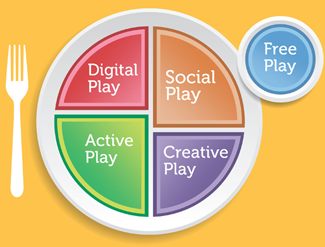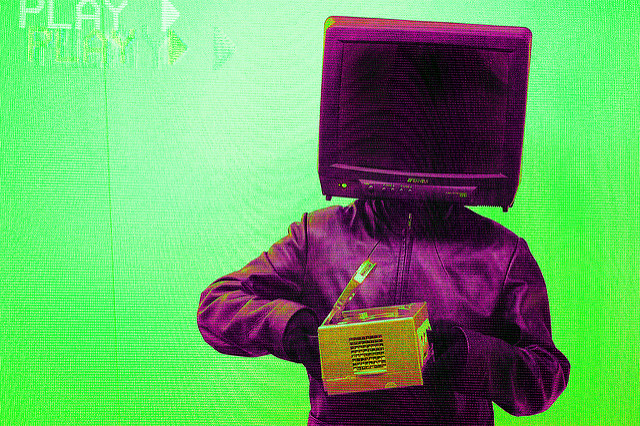For digital age parents, it’s impossible to escape the digital play vs. traditional play debate. And for some of us, just one dissenting article — no matter how ridiculously extreme or alarmist or how much evidence we read to the contrary — can send us spiraling in doubt. Am I ruining my child’s mind by letting them play video games? Can video games and imagination co-exist?
It’s not my job to sell parents on the digital age, it’s my job to help them navigate it. That means I have to stay on top of research, news, opinions, and trends in technology, education, and psychology. I want to make it very clear that kids need a balanced Play Diet, one that includes social, creative, free, and active play as well as digital play. But I can say with complete conviction that video games and imagination aren’t the mortal enemies some would have us believe.

The LW4K recommended Play Diet.
Chandra Johnson does a good job of highlighting the conflicting expert opinions on technology and child development in a recent piece for Utah’s Deseret News, “How modern kids use their imaginations”. Johnson herself makes no outright value judgements, but I’m going to because this is important.
Before I go any further there are four simple rules to remember:
- Social media usage and video gameplay are different.
- Television and video gameplay are different.
- Active and AR games and traditional (couch-play) video games are different.
- Not all couch-play games are the same.
Now for the loudest voice of dissent in Johnson’s compilation: Kristen Race, a psychologist who specializes in mindfulness. “Even though a child may be playing [Pokémon GO] outside, his brain is functioning in the exact same way it would if he were spending hours in an arcade,” Race writes, “The only difference is now he needs sunscreen.” This simply isn’t true.
Dr. Race ignores the science behind rules 2 and 3, which is that there is a difference between active and passive media consumption. Playing video games is a lot healthier for the brain than watching TV, and active and AR games have additional benefits.
Neuroscientist Colin Ellard admits this in another article that Johnson references, though Ellard is in favor of ditching the games altogether in favor of some good old-fashioned outdoor time. I won’t deny that outdoor time is valuable and necessary. We want your kids to run around outside as much as we want you to play video games with them. But for many neurodiverse people, it’s not that simple. Parents have come out of the woodwork to praise Pokémon GO for pushing their kids out of their comfort zones.

Pokémon GO has encouraged outdoor and social play on an unprecedented scale. | Image: Flickr user Daniel X. O’Neil
While Ellard’s research on the positive physiology of being outdoors is valuable, what he has to say about Pokémon GO and other video games is largely conjecture. A player’s engagement with the game, Ellard writes, is “probably [emphasis mine] causing patterns of brain activation that are not very different from those experienced by players of first-person shooters.” Except that there is a huge difference between being outside and engaging with one’s community and neighbors and sitting on the couch playing a first-person shooter. Not that first-person shooters are brain-killers. They may not be the most wholesome games, but recent studies show that first-person shooters increase cognitive function, spatial reasoning, decision-making, and other skills.
Now let’s talk about rule #1. “Technologies [sic] use such as social media, experts argue, take away from boredom,” Johnson writes, “a key component in the kind of ‘free play’ that fosters creativity as well as social and emotional development.” It’s true that both video games and social media can cure boredom, and it’s easy to lump them together under the larger header of technology. But social media and video games are not the same technologies, and the factors that lead a child to gravitate toward one more than the other vary widely. Research shows that kids who play online video games do better in school than kids who spend their time socializing online. And while digital play and free play are in separate categories of the recommended Play Diet, they aren’t mutually exclusive. Kids experience digital free play in sandbox video games like Minecraft and apps like those in the Toca Boca series of “digital toys.” And digital free play is better than no free play at all.

Minecraft is a sandbox game that allows players to create from their imaginations. | Image: Flickr user Mike Prosser
Even the seemingly pro-Pokémon GO article Johnson references subtly perpetuates the misconception that video games and other technologies are inherently anti-imagination. In an article for The Atlantic, Georgia Perry speculates that AR games will “make imaginative play…mainstream again.” The problem with this kind of thinking? Imagination has always been mainstream. It just looks different in the digital age. Throughout history various mediums and hobbies have been feared as mentally unhealthy — comics, movies, video games, even chess (yes, really. Chess). And yet imagination has survived thrived.
Here at LearningWorks for Kids we advocate for video games because we truly believe they are valuable instruments for children’s play as well as for their education. We dedicate countless hours to researching the risks and benefits of technology to help you set reasonable screen time limits and get the most out of the video games, apps, and social media platforms your kids already use and love. Our Playbooks and App+ guides are learning guides designed to aid parents in playing and using games and apps with their kids, talking about technologies and the skills they exercise, and translating those skills to daily life. To learn more about our philosophy on games and learning, read about the science behind LW4K.
Featured image: Flickr user Cam Evans.




